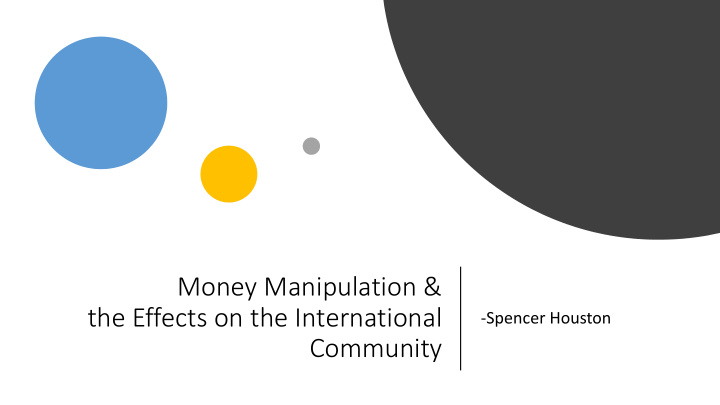



Money Manipulation & the Effects on the International -Spencer Houston Community
Definition of Money Manipulation Types of Money Manipulation How Money Manipulation Overview Works Why is Money Manipulation Controversial Examples of Money Manipulation
Money Manipulation, Currency Intervention, Currency Manipulation, and Foreign Exchange Market Intervention. Definitions The acquisition or sale of a foreign assets in exchange for their own domestic currency, with the intent to influence or change a currency’s exchange rate or a country’s trade policy
Types of Money Manipulation • Direct Intervention vs. Indirect Intervention • Direct Intervention: - Foreign exchange transactions that are handled by a country’s monetary authority, to directly influence the currency’s exchange rate • Indirect Intervention: - Policies that indirectly change a country’s exchange rate such as capital controls and exchange controls (taxes, subsidies, restriction of currency trade)
Types of Money Manipulation • Sterilized Intervention vs. Unsterilized Intervention • Sterilized Intervention: - The purchase or sale of foreign assets to influence the exchange value of the domestic currency without changing the monetary base • Unsterilized intervention: - An attempt by a country's monetary authority to influence exchange rates by changing their monetary base
How Sterilized Intervention Works Euro-denominated European Federal bonds ($10 Billion) Central Reserve $14 Billion Bank $14 $14 Billion of Billion US T-bills Sterilization Intervention Open Market
Effects of Sterilized Intervention • Most empirical research suggests that sterilized intervention does not work • Theory says it could through two different ways: 1. Portfolio Balance Channel: Rebalancing of a countries private agents’ bond portfolios. Portfolios consist of domestic money and bonds and foreign money and bonds. Given certain conditions, economic changes can change portfolios and thus change exchange rates. 2. Expectations (Signaling) Channel: Agents may consider sterilized intervention as a signal about future policy and the change in expectation will change exchange rates.
Portfolio Balance Approach • Four Assets: Home and Foreign Currency, and Home and Foreign Bonds. • Home and Foreign Assets are not perfect substitutes • Public agents have an equilibrium amount of Foreign and Home bonds • After sterilization: o No change in domestic interest rates (because no money base change) o A change in portfolio composition. • Example: Home buys foreign bonds, so a decrease in foreign bonds • A sterilizing open market sale of domestic bonds occurs • This leads investors to shift their optimal portfolio because a rise in relative price of foreign bonds. The private domestic investors will theoretically sell their foreign assets for the relatively cheaper domestic assets.
How Unsterilized Intervention Works Euro-denominated European Federal bonds ($10 Billion) Central Reserve $14 Billion Bank M≡NFA+(NDA−NW)≡NFA+DC (1) Where, (DC ≡ NDA − NW) (2) Sterilized: ∆DC = −∆NFA (3) ∆M = ∆NFA + ∆DC = 0 (4) ∆NDA = −∆NFA (5)
Effects of Unsterilized Intervention • In general, a strong consensus exists that unsterilized intervention can influence the exchange rate similarly to monetary policy by inducing changes in the stock of the money base • Unsterilized intervention has the same impact on monetary liabilities as an open market operation • Acts like an open-market transaction
Undervaluing Currency, Why? • Maintain Export Competitiveness • Control Inflation • Financial Stability (less volatility in exchange rates) • If a foreign country devalues currency relative to USD: • Benefits: US Consumer and Foreign Exporter • Hurts: US Exporter and Foreign Consumer
What do the WTO and IMF Have to Say? • IMF: Article IV, Section 1 General Obligations of Members, Part iii: “avoid manipulating exchange rates or the international monetary system in order to prevent effective balance of payments adjustment or to gain an unfair competitive advantage over other members” • The IMF can exercise “firm surveillance” but it cannot compel a country to change its exchange rate.
What do the WTO and IMF Have to Say? • WTO: SCM Agreement: A subsidy is defined as:
Money Manipulation in Politics • 2012 Election – Mitt Romney Vows to label China as a Money Manipulator if elected to office • Aug 28, 2015 – Marco Rubio accuses China • Oct 16, 2015 – Bernie Sanders accuses China • Jan 7, 2016 – John Kasich accuses China • Feb 24, 2016 – Hillary Clinton accuses China, Japan, and other Asian Economies
Money Manipulation in Politics • Trump’s Stance on Money Manipulation • Nov 30, 2011 – First accuses China of being Currency Manipulator • Maintains opinion through 2016 election • Apr 12, 2017 – Flips stance after meeting with Xi Jinping – North Korean threat
China, a Currency Manipulator? • 1990s and 2000s: A marked increase of US imports from China • Allegedly: With trade surplus. China buys US debt to devalue the Chinese. Increases supply of Yuan, while increasing demand for dollar. Thus increasing price of USD. • China’s Foreign exchange Reserves = $3 trillion dollars
Japan • Deflationary pressures from 1989 to 2003 • Purchase of $320 Billion in US debt • 2013 openly told public they planned to buy euro-bonds to weaken the Yen • End of 2013: $1.27 trillion in foreign reserves • Claims long-standing deflationary pressure is the reason
Work Cited • “Articles of Agreement.” Articles of Agreement of the International Monetary Fund -- 2016 Edition , https://www.imf.org/external/pubs/ft/aa/index.htm • Craig, Ben R., and Owen F. Humpage. “Sterilized Intervention, Nonsterilized Intervention, and Monetary Policy.” Working Paper (Federal Reserve Bank of Minneapolis) , 2001, https://www.minneapolisfed.org/research/qr/qr1032.pdf • Sanford, Jonathon E. Currency Manipulation: The IMF and WTO . Currency Manipulation: The IMF and WTO . https://fas.org/sgp/crs/misc/RS22658.pdf • Sarno, Lucio, and Mark P Taylor. “Official Intervention in the Foreign Exchange Market: Is It Effective and, If So, How Does It Work?” Journal of Economic Literature , vol. 39, no. 3, 2001, pp. 839–868., doi:10.1257/jel.39.3.839. http://www.cass.city.ac.uk/__data/assets/pdf_file/0008/40697/sarno_taylor_jel.pdf • “Sterilized Intervention.” Investopedia , 28 Oct. 2013, https://www.investopedia.com/terms/s/sterilizedintervention.asp • “Unsterilized Foreign Exchange Intervention.” Investopedia , 22 Sept. 2005, https://www.investopedia.com/terms/u/unsterilized.asp • “WORLD TRADE ORGANIZATION.” WTO | Understanding the WTO - Anti-Dumping, Subsidies, Safeguards: Contingencies, Etc , https://www.wto.org/english/thewto_e/whatis_e/tif_e/agrm8_e.htm
Recommend
More recommend